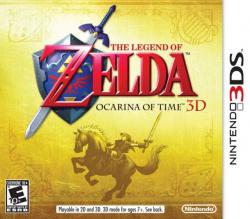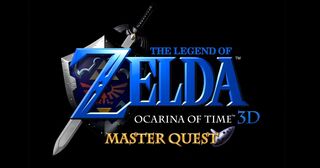 The Legend of Zelda: Ocarina of Time 3D (Nintendo 3DS)
The Legend of Zelda: Ocarina of Time 3D (Nintendo 3DS)
User Review
Product Information:
- Release Date (NA): June 14, 2011
- Publisher: Grezzo
- Genres: Action-Adventure, Role-Playing Games
Game Features:
Single player
Local Multiplayer
Online Multiplayer
Co-operative
Review Approach:
I had loved Ocarina of Time back when it released on the Nintendo 64, and on top of that I had $35 of credit from Amazon's Nintendo 3DS release promotion so I was able to snag this game for $5.
The Legend of Zelda: Ocarina of Time was considered to be one of the best games of all time, because it set the groundwork for full 3D environments. In 2011, Grezzo took the helm and began a remake of the classic, which was released in Summer 2011 to positive reviews.
Story
The game's story line has not changed from the Nintendo 64 edition. You start out as a young Link, a child growing up in the Kokiri Forest. It is time for you to take responsibility, as the Kokiri Tree is dying. On his dying wishes, you travel out of Kokiri Forest, to Hyrule, where you meet Princess Zelda and her father's advisor, Ganondorf. Ganondorf is a suspicious person in the eyes of Zelda, and later, the former kidnaps the princess; however, she tosses the Ocarina of Time into a moat for you to retrieve. Thus begins a journey that spans seven years into the future, and armed with the Master Sword you are to save Hyrule.
Gameplay
The gameplay of Ocarina of Time has not changed from the original. You are armed with an array of equipment that will be helpful throughout the game's many dungeons. Collecting Rupees along the way will help by allowing you to purchase equipment, and upgrade your gear. The gameplay consists of Link traveling throughout Hyrule and entering a series of dungeons, filled with puzzles, to obtain the items necessary to save Princess Zelda.

When Link ages seven years and becomes the "adult" Link, sometimes, gear cannot be used because he is too big. An example is the slingshot. Link does not get to use that in his adult form, and in his child form there are adult items that the child cannot use. The use of the touch screen gives a seamless experience that prevents the clunkiness that was brought about within the Nintendo 64 game. Such improved elements included the use of a touchscreen map, or a touchscreen button for a specific item of choice. This eliminated the many complaints that many had in the Nintendo 64 version's Water Temple, which proved frustrating to users due to the constant need to switch items back and forth.
Visuals
The game visuals have changed significantly. No longer is Link looking like a crudely drawn polygonal mess, as now Link has distinctly rounded facial features. Environments look realistic; an example of this is the running water that is found in Hyrule Field, which has a clear blue sheen as seen in real life, in comparison to the opaque colors in the Nintendo 64 version.

Content and Replayability
The game has plenty of content, in the form of dungeons, minigames, and collection. The storyline portion of the game took me about 32 hours. Collecting and minigames are bound to leave a lot more. I personally went in and collected all the spirits needed to break the curse, and it was quite the rewarding experience to be able to finish that.

Music
I have to admit, Grezzo really missed a golden opportunity here. The music from this game is the exact same as it was in the Nintendo 64 edition. They really missed a golden opportunity to orchestrate it to make the game perfect, but they chose not to. What I find puzzling is that I was looking for the orchestrated tracks throughout the game, hoping that it existed, but I found that the one orchestrated track is where I barely pay attention to, the end credits. It was a nice touch, but if it were me, they should definitely used that as a groundwork and orchestrated throughout the entire game.
Should You Buy It?
The game is a worthy enough purchase because of its fresh look, its revamped user interface. The game is polished enough so that it does not feel like a one off port of a classic. It is a lot easier to manage inventory and switch between items on the fly. For any Zelda fan, this should be a definite purchase to pick up.
The game's story line has not changed from the Nintendo 64 edition. You start out as a young Link, a child growing up in the Kokiri Forest. It is time for you to take responsibility, as the Kokiri Tree is dying. On his dying wishes, you travel out of Kokiri Forest, to Hyrule, where you meet Princess Zelda and her father's advisor, Ganondorf. Ganondorf is a suspicious person in the eyes of Zelda, and later, the former kidnaps the princess; however, she tosses the Ocarina of Time into a moat for you to retrieve. Thus begins a journey that spans seven years into the future, and armed with the Master Sword you are to save Hyrule.
Gameplay
The gameplay of Ocarina of Time has not changed from the original. You are armed with an array of equipment that will be helpful throughout the game's many dungeons. Collecting Rupees along the way will help by allowing you to purchase equipment, and upgrade your gear. The gameplay consists of Link traveling throughout Hyrule and entering a series of dungeons, filled with puzzles, to obtain the items necessary to save Princess Zelda.

When Link ages seven years and becomes the "adult" Link, sometimes, gear cannot be used because he is too big. An example is the slingshot. Link does not get to use that in his adult form, and in his child form there are adult items that the child cannot use. The use of the touch screen gives a seamless experience that prevents the clunkiness that was brought about within the Nintendo 64 game. Such improved elements included the use of a touchscreen map, or a touchscreen button for a specific item of choice. This eliminated the many complaints that many had in the Nintendo 64 version's Water Temple, which proved frustrating to users due to the constant need to switch items back and forth.
Visuals
The game visuals have changed significantly. No longer is Link looking like a crudely drawn polygonal mess, as now Link has distinctly rounded facial features. Environments look realistic; an example of this is the running water that is found in Hyrule Field, which has a clear blue sheen as seen in real life, in comparison to the opaque colors in the Nintendo 64 version.

With the enabling of 3D, the Hyrule Field looks vast and immersive, giving the feeling that you are very small. Its expansiveness does come with the downside that a lot of walking is needed, as it is not until later that you receive a faster means of transportation. What that means is that you will be rolling to get across Hyrule Field faster for the majority of the time, easing the boredom of travel by killing stray enemies that you happen to encounter.Content and Replayability
The game has plenty of content, in the form of dungeons, minigames, and collection. The storyline portion of the game took me about 32 hours. Collecting and minigames are bound to leave a lot more. I personally went in and collected all the spirits needed to break the curse, and it was quite the rewarding experience to be able to finish that.

Another point that is worth mentioning is that this game has the Master Quest mode enabled after you kill Ganondorf the first time around. The Master Quest is a bit more challenging in terms of enemies and dungeon layout as the world basically is "reversed." It basically is a fresh game again. In all honesty though, I found Master Quest actually easier than the first run through the game.Music
I have to admit, Grezzo really missed a golden opportunity here. The music from this game is the exact same as it was in the Nintendo 64 edition. They really missed a golden opportunity to orchestrate it to make the game perfect, but they chose not to. What I find puzzling is that I was looking for the orchestrated tracks throughout the game, hoping that it existed, but I found that the one orchestrated track is where I barely pay attention to, the end credits. It was a nice touch, but if it were me, they should definitely used that as a groundwork and orchestrated throughout the entire game.
Should You Buy It?
The game is a worthy enough purchase because of its fresh look, its revamped user interface. The game is polished enough so that it does not feel like a one off port of a classic. It is a lot easier to manage inventory and switch between items on the fly. For any Zelda fan, this should be a definite purchase to pick up.
Verdict
What I Liked ...
- -Great improvement over the classic
- -Easier to switch between items
- -Excellent visuals
- -Master Quest content added!
What I Didn't Like ...
- -Soundtrack is the exact same as the N64 soundtrack.
8
Gameplay
The gameplay is almost the same as most Zelda titles, but could be repetitive after a little while. Gameplay is a little simplistic though, compared to later titles like Skyward Sword or Twilight Princess.
9
Presentation
The visuals are exciting, vibrant, and rounded, no longer using the polygons that plagued the Nintendo 64 version. An easy to use interface eliminates the inconveniences of constantly switching to the menu to change items.
9
Lasting Appeal
The game has definitely aged well, and the addition of Master Quest is huge in terms of adding new content.
8.9
out of 10